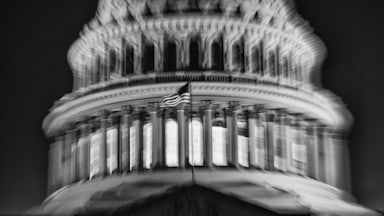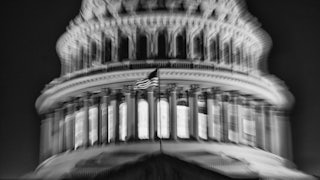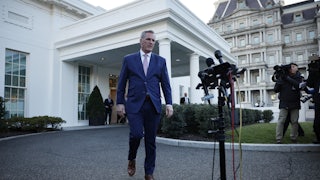Congress is careening once more towards a brutal fight over raising the nation’s borrowing cap, with dire economic consequences in store should the United States default on its debts. Negotiations seem to be moving at a glacial pace even as the Treasury Department has resorted to “extraordinary measures” to ensure the bills are paid for the time being. Republican lawmakers insist they will not vote to raise the debt limit without significant spending cuts, while Democrats argue that the ceiling should be lifted in a “clean” bill, without any conditions.
If the U.S. fails to pay its debts, the federal government will be unable to make critical payments for programs such as Medicare, Social Security, veterans’ benefits and military salaries. Along with the national repercussions, default would likely shock global markets, with international ripple effects. With resolution uncertain, the country creeps ever closer to the so-called “X date”—the day on which the U.S. will be unable to fulfill its obligations—threatening the balance of the global financial system that relies on the stability of the American dollar.
The U.S. dollar is currently the primary global reserve currency, dominant largely because it is considered to be stable. “U.S. debt is frequently viewed by global financial markets as one of the safest assets in the world,” said Rachel Snyderman, the senior associate director for economic policy at the Bipartisan Policy Center. “So if our debt starts to be priced on our nation’s willingness to pay our bills, rather than our ability to pay our bills, the ramifications could range from short term market confusion and preliminary uncertainty to really long term economic damage that would extend far beyond our borders.”
There is currently high demand for U.S. treasury assets globally, and so the U.S. can borrow money at relatively low interest rates. This has helped the U.S. weather periods of economic volatility, a recent example being the upheaval wrought by the coronavirus pandemic. If investors lose confidence in the stability of U.S. treasuries, they could sell those assets, weakening the dollar and putting those low interest rates at risk. Previous debt ceiling showdowns have seen interest rate spikes: During the last battle over raising the debt ceiling, in the fall of 2021, interest rates on short-term U.S. treasury securities increased. A similar spike in one-month treasury bills occurred shortly before the X date in 2017. When the U.S. approached default in 2011 and 2013, elevated interest rates led to borrowing costs increasing by hundreds of millions of dollars.
Even though the country never actually defaulted on its debts in these instances, the mere threat was enough for investors to lose some confidence in U.S. treasury assets. The crisis of 2011 also saw Standard & Poor’s downgrade the country’s credit rating for the first time in 70 years. The brunt of increased rates is then borne by the American people. “The United States is borrowing money to issue those bonds, and the only way that it pays interest is through that revenue generation that it’s able to collect from taxpayers,” Snyderman said.
Higher interest rates on U.S. treasury assets overflow into other areas of the American economy. In times of higher financial risk, banks often increase interest rates on loans; for example, the rate that homebuyers pay for a mortgage is generally tied to the interest rate on treasury bonds. According to a 2022 analysis released by Third Way, a center-left think tank, an increase in treasury bond rates could result in a commensurate increase in rates for a 30-year mortgage, adding approximately $130,000 to the lifetime cost on a median new home loan. Interest rates on car payments and credit card payments would also increase. Adding to the burden for the American taxpayer, a depreciated dollar could also result in more expensive imports.
On an international scale, default may also threaten the status of the U.S. dollar as the global reserve currency. I’ve thrown a lot of jargon at you, so here’s a brief explanation of reserve currencies: The central bank or treasury of a country often holds a foreign currency in reserve for purposes such as paying for imports and adjusting the value of its own currency. These currencies are often held in government bonds, such as U.S. treasury bonds. The International Monetary Fund recognizes eight major reserve currencies, with the U.S. dollar comprising around 60 percent of global foreign exchange reserves.
But if investors lose faith in the stability of treasury assets—doubt precipitated by a debt ceiling breach, perhaps—they might start looking for alternatives. “That special status does not get revoked overnight, but it can decay, and would allow other currencies to rise in relative importance,” said Zach Moller, the director of the economic program at Third Way. Currently, the euro accounts for around 20 percent of global reserves, and the Chinese renminbi roughly 3 percent.
The question for investors is not whether the U.S. can pay its debts, but whether it has the political will to do so; as such, a default on debts by the U.S. would differ from that of a developing country without the financial capacity to fulfill its obligations. “It’s really a political game, or political brinkmanship, that’s driving this, not necessarily anything about the soundness of U.S. institutions, or the soundness of U.S. policy or ability to pay its debts,” said Stephen Kaplan, an associate professor of political science and international affairs at George Washington University.
The U.S. has never defaulted on its debts, but the full faith and credit of the country has been repeatedly threatened in recent years, as members of Congress continually argue over whether to raise the debt ceiling—which does not authorize new spending or incur new debt, but covers spending that has already been appropriated. As the U.S. comes close to default, the economic risk increases for foreign investors. “Even if the risk of default is kind of a tail risk, and low likelihood, somebody could make a mistake,” Kaplan said. “I don’t think it’s in the interest of any politician to really incur the cost of this game of brinkmanship. But how far do you want to push it? And as you get very close to that threshold, a mistake or an error can happen.”
That risk, however small, could thus create an incentive for foreign institutions or countries to diversify their holdings and, eventually, begin searching for other options. While there isn’t a viable alternative to the dollar as a reserve currency today, continued battles over the debt ceiling could open the door for ambitious countries to step in, argued Michael Strain, the director of economic policy studies at the American Enterprise Institute, a conservative think tank.
“If the United States wants to maintain its position in the global financial system over the next 50 years, then it needs to avoid incidents like this,” Strain said. “Nobody can step in, in the year 2023. But if the U.S. keeps opening the door and inviting that kind of competition, maybe in the year 2040, somebody will be able to.”
China has ambitions for becoming a more dominant global reserve currency, undergoing what some experts deem an “internationalization” strategy to improve its reputation among foreign investors. At a time when confronting China is one of the few ideas upon which congressional Democrats and Republicans agree, the fight over the debt ceiling could strengthen the Chinese renminbi and other currencies as the dollar weakens.
Beyond threatening the balance of the global financial system, the current fight over the debt ceiling raises questions about the country’s ability to function in a hyper-polarized era. Strain warned that these philosophical questions could in turn deter investors from business in the United States.
“You might demand a higher interest rate on debt issued by that country, but you also might say, ‘Why would I build a factory in that country? Why would I invest in corporations that are chartered in that country?’” Strain argued. “Why would I want to do business with that country, if the rule of law has deteriorated to the point where political division means that it can’t pay its bills on time?”
If lawmakers treat the debate over the debt ceiling as a regular game of political football, investors may increasingly see it as one of risk. Even without default, that calculation may eventually undermine the financial stability that has granted the U.S. dollar primacy for decades.










